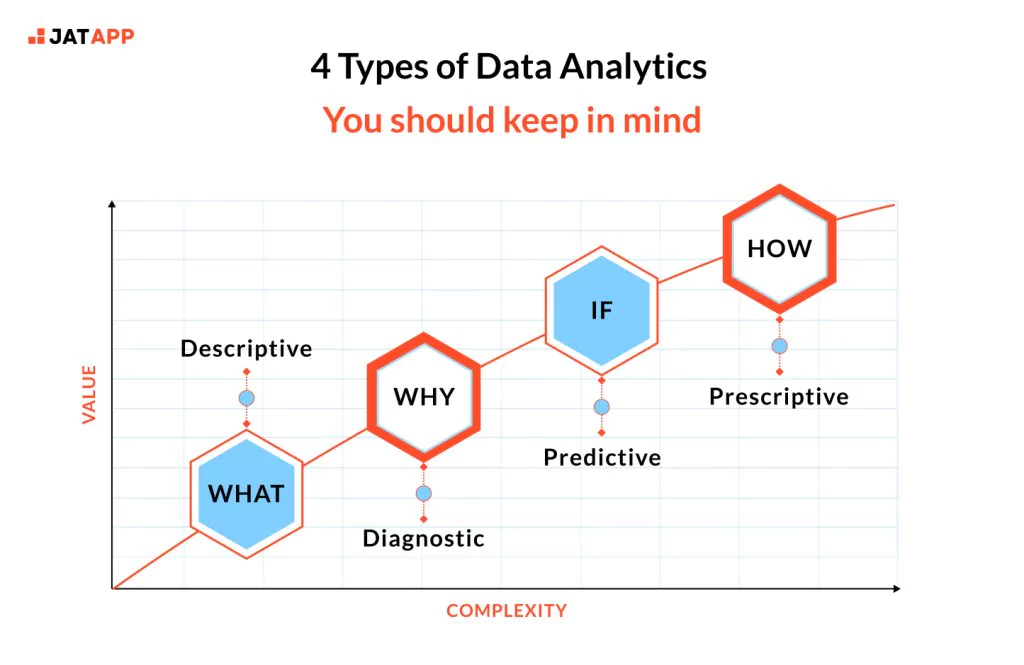4 Types of Data Analytics and Key to the Project’s Success and Prosperity
The modern world is built on information. People receive messages, notifications, and updates; read news and scroll our newsfeed. Companies get updates about markets, the value of their shares, sales, and other indicators literally every second. And it doesn’t matter whether you are working in HR, production, marketing, or finances – everything is surrounded by information. Actually, data and analytics are the pillars of your performance.
That is why people and companies wonder how it is possible to turn unstructured information into a source of valuable insights? The answer is simple: to use the analytics approach. By evaluating and analyzing information, it is possible to describe obtained results, diagnose possible problems, predict outcomes, and create a clear plan of action. Having such information will surely give you an advantage over competitors, and we are ready to share the most valuable tips right now.
4 types of data analytics you should keep in mind
Data analytic is an extremely interesting science and can give you lots of valuable insights about the company, product, customers, and whatnot. To achieve the best results, you should pick the most suitable approach. Here are the different types of analytics that exist at the moment:
- What: descriptive analytics
- Why: diagnostic analytics
- If: predictive analytics
- How: prescriptive analytics
Descriptive Analytics: What?
It is rather simple to answer the question of what is descriptive analytics because it lies in a single word: FACTS. Descriptive analytics is about collecting information from metrics, statistics, dashboards, and reports. All descriptive analytics techniques answer the same What question. For example, what is the number of sales in New York? What is our annual revenue?
Descriptive analysis is the first step to creating an analytical strategy, and surveys show that more than 80% of strategies are based on data collected in the past.
Descriptive analytics examples
The best way to picture descriptive analytic approach is to get familiar with the examples:
- Surveys
- General tendencies and trends
- Documentation and reports
- Summaries of previous marketing campaigns
- Social media information
Descriptive data analytics is a great source of information that allows making predictions and improving the modern state of affairs.
Diagnostic Analytics: Why?
The next type of data analytics is called diagnostic. As well as the descriptive one, it focuses on obtained results. But instead of plain facts, it is interested in the reasons why a particular event or result took place. The main goal of the diagnostic analysis is to compare the past and distinguish causes. With the help of this analytics, it is possible to identify hidden problems or isolate relationships between situations.
To understand Why something happened, the diagnostic analysis uses such techniques as sensitivity and regression analysis.
Diagnostic analytics examples
Examples of the diagnostic analytic types may be very different. Let us name a few:
- Comparing different candidates to understand who suits the most
- Testing social media responses to evaluate why the conversion has dropped
- Reaching out to regional sales managers to find out why the stores are following this or that pattern
Predictive Analytics: If
While descriptive and diagnostic analytics collect data, it is the predictive data analysis that turns information into insights for future decision-making. However, this doesn’t mean that the analysis will tell you what is going to happen. Instead, it will make assumptions based on the previous results and situations. For example: ‘Based on the sales decline during the 2018 crisis, we might lose 15% if we don’t change the strategy.’ The best way to answer the question of what is predictive analytics is to name two words: correlation and probability.
When using this approach, specialists use quantitative analysis and build predictive models. Creating them takes lots of time and skills, so predictive data analytics is in huge demand.
Benefits of predictive analytics
As you understand, predictive approach will never be as accurate as descriptive or diagnostic analytic instruments. It is based on assumptions and many specialists remain rather sceptical about predictive models. However, it is impossible to deny the advantages this approach can offer:
- Effectiveness
- Reaching customers
- Prevention of scams and frauds
- Risk minimization
Predictive analytics tools can help to forecast inventory, supplies, and other expense items, which in turn may significantly boost efficiency. This approach is also good for understanding customers and their needs. Finally, it can be useful in identifying fraud patterns and reducing risks.
Prescriptive Analytics: How
Prescriptive analysis significantly relies on the predictive approach and makes recommendations based on the predicted outcomes. This approach helps companies and individuals to achieve numerous goals.
A prescriptive model is teaching itself through review mechanisms and constant analysis of relationships and events. By simulating the environment and collecting up-to-date prescriptive data, this type of analytics is able to help with achieving the most specific goals. This approach often uses such instruments as machine learning and artificial intelligence.
Prescriptive analytics examples
Prescriptive statistics is very interesting and more and more analysts and companies turn to this approach in order to boost efficiency and profitability. And the best part is that prescriptive analytics techniques can be used across numerous industries. For example:
- Tracking oil prices and their fluctuations
- Improving management of storage and production
- Evaluating cost effectiveness of healthcare procedures
- Finding the best groups for pharmaceutical trials
The most common approaches
It may be a challenge to define which type of analytics is the most popular and effective one. Fortunately, there have been numerous researches on the topic that can shed light. For example, in 2016, The Global Data and Analytics survey has interviewed more than 2,000 specialists to find out which models allow making the best decisions. Almost 60% of respondents have chosen descriptive data analytics and 34% – diagnostic analytics. But in 2018, the tendencies have changed, and prescriptive and predictive analytics, which is called advanced analytics, is now leading the race.
However, extra surveys have shown that to achieve the best results, and it is necessary to combine at least two types of analytics. Or to use specific approaches to concrete problems.
Which data analytics do you require?
Below we have described each type of analytics in much detail. However, you might still have doubts about what type is the most suitable one. To make the right decision, we recommend starting with answering the following questions:
- How’s data analytics performed at the moment?
- How much time and money am I ready to invest in data analytics?
- Do I have a strong team of analysts?
- What instruments do I possess?
The answers may help you choose a suitable data analytics solution. Ideally, the chosen approach should allow performing analytical approaches starting with the easiest ones and then proceed with more complex instruments. If this sounds too difficult, you might want to hire a team of analysts who offer turn-key solutions. With their help, you can save lots of energy and money and achieve the best results as quickly as possible.



